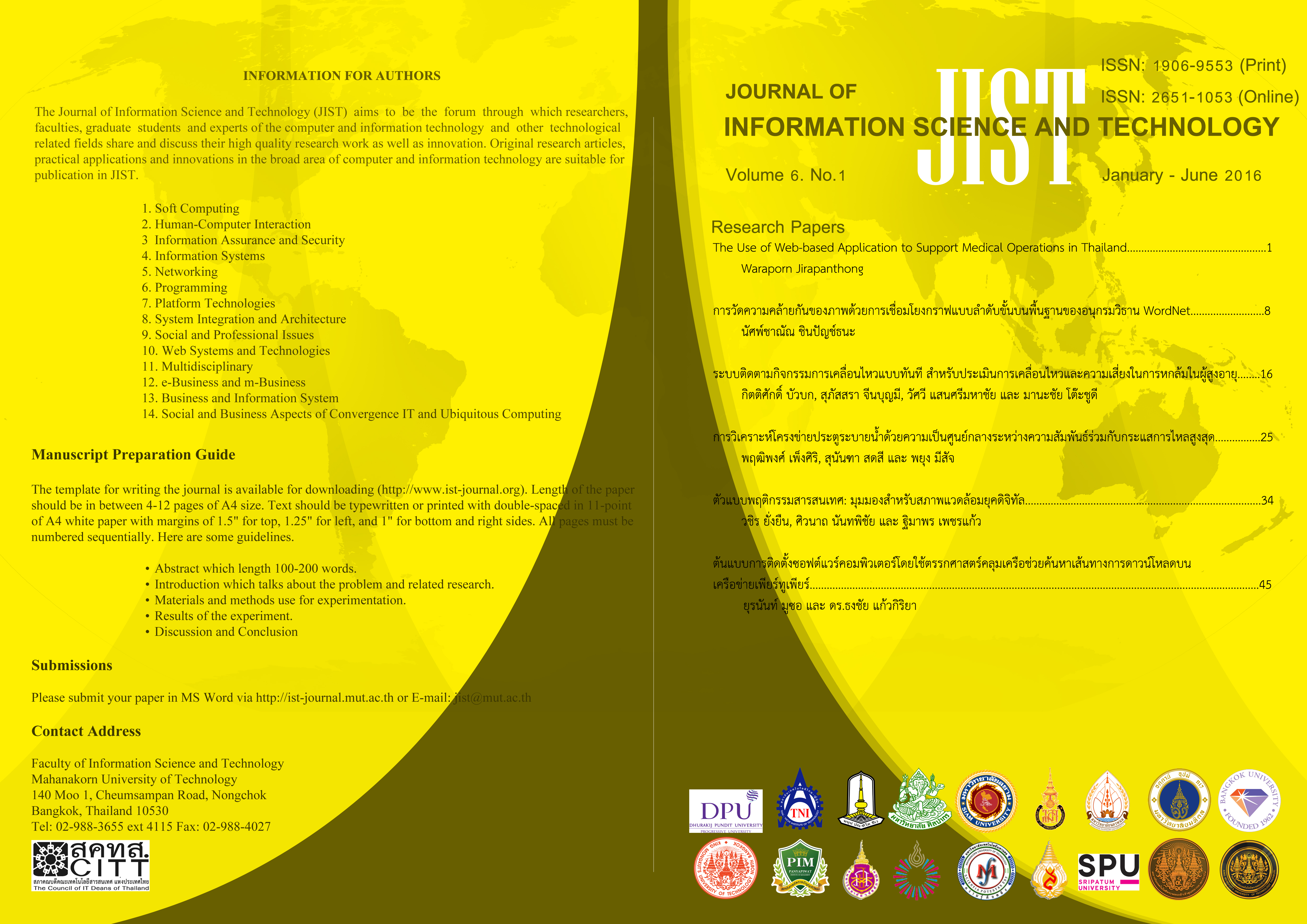ระบบติดตามกิจกรรมการเคลื่อนไหวแบบทันที สำหรับประเมินการเคลื่อนไหวและความเสี่ยงในการหกล้มในผู้สูงอายุ
Main Article Content
บทคัดย่อ
- ในช่วงทศวรรษที่ผ่านมา โครงสร้างประชากรของประเทศไทยมีการเปลี่ยนแปลงอย่างมีนัยยะสำคัญ โดยสัดส่วนของประชากรผู้สูงอายุเพิ่มขึ้นอย่างรวดเร็วและต่อเนื่อง และคาดการณ์ว่าในอีกไม่เกิน 20 ปีข้างหน้า ประเทศไทยจะเข้าสู่สังคมผู้สูงอายุระดับสุดยอด หนึ่งในปัญหาสำคัญของผู้สูงอายุ ได้แก่ ภาวะหกล้ม ซึ่งคือ ภาวะที่ผู้สูงอายุมีปัญหาการทรงตัวและการเคลื่อนที่ไม่มีประสิทธิภาพ ซึ่งนำไปสู่การหกล้มบ่อยภาวะดังกล่าวผลกระทบต่อผู้สูงอายุอย่างมากทั้งด้านร่างกายและจิตใจ นำไม่สู่ปัญหาทางสุขภาวะสำคัญอื่นๆ เช่น ภาวะกระดูกหัก (Fracture) และความพิการทางร่างกาย อีกทั้งบ่อยครั้งเป็นอันตรายถึงชีวิต ผู้จัดทำจึงมีแนวคิดในการพัฒนาระบบที่สามารถติดตามกิจกรรมการเคลื่อนไหวและประเมินความเสี่ยงในการหกล้มของผู้สูงอายุจากระยะไกล ระบบมีความสามารถในการจำแนกและวิเคราะห์กิจกรรมที่เกี่ยวข้องกับการเคลื่อนไหวแบบทันที จัดเก็บประวัติการทำกิจกรรม ประเมินความเสี่ยงในการหกล้มของผู้สูงอายุ ผลการทดสอบประสิทธิภาพสามารถการันตีได้ว่า ระบบต้นแบบที่พัฒนาขึ้นสามารถปฏิบัติงานภายใต้สภาพแวดล้อมการทำงานจริงได้อย่างมีประสิทธิภาพ ด้วยความถูกต้องในการจำแนกกิจกรรมการเคลื่อนไหวเฉลี่ย ร้อยละ 93.90
Article Details
This work is licensed under a Creative Commons Attribution-NonCommercial-NoDerivatives 4.0 International License.
I/we certify that I/we have participated sufficiently in the intellectual content, conception and design of this work or the analysis and interpretation of the data (when applicable), as well as the writing of the manuscript, to take public responsibility for it and have agreed to have my/our name listed as a contributor. I/we believe the manuscript represents valid work. Neither this manuscript nor one with substantially similar content under my/our authorship has been published or is being considered for publication elsewhere, except as described in the covering letter. I/we certify that all the data collected during the study is presented in this manuscript and no data from the study has been or will be published separately. I/we attest that, if requested by the editors, I/we will provide the data/information or will cooperate fully in obtaining and providing the data/information on which the manuscript is based, for examination by the editors or their assignees. Financial interests, direct or indirect, that exist or may be perceived to exist for individual contributors in connection with the content of this paper have been disclosed in the cover letter. Sources of outside support of the project are named in the cover letter.
I/We hereby transfer(s), assign(s), or otherwise convey(s) all copyright ownership, including any and all rights incidental thereto, exclusively to the Journal, in the event that such work is published by the Journal. The Journal shall own the work, including 1) copyright; 2) the right to grant permission to republish the article in whole or in part, with or without fee; 3) the right to produce preprints or reprints and translate into languages other than English for sale or free distribution; and 4) the right to republish the work in a collection of articles in any other mechanical or electronic format.
We give the rights to the corresponding author to make necessary changes as per the request of the journal, do the rest of the correspondence on our behalf and he/she will act as the guarantor for the manuscript on our behalf.
All persons who have made substantial contributions to the work reported in the manuscript, but who are not contributors, are named in the Acknowledgment and have given me/us their written permission to be named. If I/we do not include an Acknowledgment that means I/we have not received substantial contributions from non-contributors and no contributor has been omitted.
เอกสารอ้างอิง
2. สถาบันวิจัยประชากรและสังคม มหาวิทยาลัยมหิดล, การสูงวัยของประชากรไทย พ.ศ. 2557, http://www.ipsr.mahidol.ac.th/ipsrbeta/th/BookReport.aspx, (เข้าถึงครั้งล่าสุดเมื่อวันที่ 8 กันยายน 2559).
3. Y.-W. Bai, S.-C. Wu and C.-L. Tsai, “Design and implementation of a fall monitor system by using a 3-axis accelerometer in a smart phone”, IEEE Transactions on Consumer Electronics, Vol. 58, No. 4, pp. 1269-1275, Nov. 2012.
4. S. Dernbach, B. Das, C. N. Krishnan, B. L. Thomas and D. J. Cook, “Simple and Complex Activity Recognition through Smart Phones”, in Proceedings of IE 2012, 2012, pp. 214-221.
5. C. Jalayondeja, “Falls screening by Timed Up and Go (TUG)”, Journal of Medical Technology and Physical Therapy, Vol 26, No. 1, pp. 5 -16.
6. P. Jantaraprim, P. Phukpattaranont, C. Limsakul and B. Wongkittisuksa, “Fall detection for the elderly using a support vector machine”, International Journal of Soft Computing and Engineering, Vol. 2, No. 1, Mar. 2012, pp. 484-490.
7. J. R. Kwapisz, G. M. Weiss and S. A. Moore, “Activity Recognition Using Cell Phone Accelerometers”, ACM SIGKDD Explorations Newsletter, Vol. 12, No. 2, pp. 74-82.
8. O. D. Lara and M. A. Labrador, “A survey on human activity recognition using wearable sensors”, IEEE Communications Surveys Tutorials, Vol. 15, No. 3, Jan. 2013, pp. 1192-1209.
9. J. W. Lockhart, G. M. Weiss, J. C. Xue, S. T. Gallagher, A. B. Grosner, and T. T. Pulickal, “Design considerations for the wisdm smart phonebased sensor mining architecture”, in Proceedings of SensorKDD’11, 2011, pp. 25-33.
10. S. Mathias, U. S. Nayak and B. Lsaacs, “Balance in elderly patients: the get-up and go test”, Arch Phys Med Rehabil, Vol. 67, No. 6, pp. 387-389.
11. D. Podsiadlo and S. Richardson, The time “Up & Go”: a test of basic functional mobility for frail elderly persons. J Am Geriatr Soc, Vol. 39, No.2, Feb. 1991, pp. 142-148.
12. N. Ravi, N. Dandekar, P. Mysore, and M. L. Littman, “Activity recognition from accelerometer data”, in Proceedings of IAAI 2005 - Volume 3, 2005, pp. 1541–1546.
13. F. Sposaro and G. Tyson, “iFall: An android application for fall monitoring and response”, Proceedings of EMBC’09, 2009, pp. 6119-6122.



